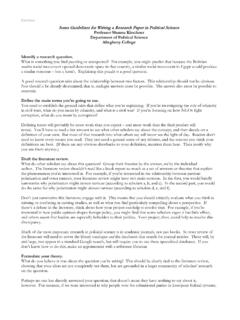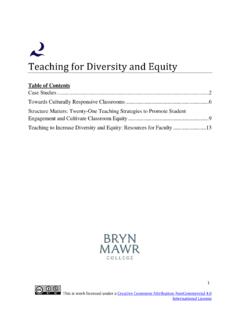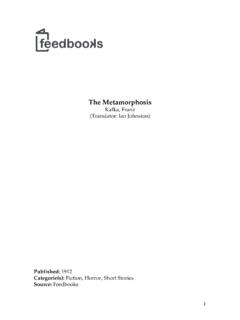Transcription of Life Cycles - Metamorphosis Aquatic Insect Life Cycles
1 Creek Connections Aquatic Macroinvertebrates Module Aquatic Insect life Cycles Aquatic Insect life Cycles Grade Level: Basic or intermediate. Duration: 50 minutes Setting: classroom Summary: Student will conduct background academic research on different Aquatic insects. Objectives: Discover that there is a great diversity of Aquatic insects each with unique identification characteristics, behaviors, habitat needs, and ecosystem roles. Vocabulary: Metamorphosis , complete Metamorphosis , incomplete Metamorphosis Related Module Resources: Book resources Materials (Included in Module): Aquatic Insect life cycle Photo Quiz (file online to project) life cycle Fact Sheets and transparency Dragonfly life cycle Plastomount Mosquito life cycle Plastomount Connect Four or Three Game Board life cycle Stages Game Pieces Aquatic Insect Fact Sheets for individual bugs Aquatic Insect life cycle Worksheet Mosquito life cycle (handout or file to project) Additional Materials (NOT Included in Module).
2 Toddler picture of teacher Projector/SmartBoard Internet ACADEMIC STANDARDS (ENVIRONMENT AND ECOLOGY) 7th Grade Explain the effects of water on the life of organisms in a watershed. Describe the life cycle of organisms that depend on water. Identify organisms that have Aquatic stages of life and describe those stages. Explain the concepts of Cycles . Identify and explain Cycles within an ecosystem. Analyze the role of different Cycles within an ecosystem. BACKGROUND: It is estimated that 7% of the 91,000+ North American insects are Aquatic or semi- Aquatic . In every part and type of waterway, these organisms can be found.
3 Aquatic insects are a varied group, but they all have one thing in common at one stage during their life cycle , they rely on water. The majority of Aquatic macroinvertebrates that inhibit waterways are simply the juvenile form of an adult, land-dwelling Insect . Many Aquatic insects start life off underwater. Because their immature Aquatic bodies are specially suited for life underwater, they often do not resemble their land-dwelling, adult body. Before the juvenile Aquatic Insect can leave its original Aquatic home, it must undergo several physical changes to prepare itself for life on land. This change in physical appearance is called Metamorphosis .
4 The extent of change that the Aquatic organism undergoes varies from organism to organism. There are two types of Metamorphosis : complete Metamorphosis and incomplete Metamorphosis . life Cycles - Metamorphosis Adapted from: An original Creek Connections activity. Creek Connections, Allegheny College, Meadville, Pennsylvania 16335. Creek Connections Aquatic Macroinvertebrates Module Aquatic Insect life Cycles Almost 90% of the insects that undergo Metamorphosis undergo complete Metamorphosis . Complete Metamorphosis consists of four stages. The organism begins as an egg, then is hatched a larvae, (often resembles little of mature adult), which gradually matures into a pupa, which then enwraps itself into a cocoon, where it finally transforms into the adult land-dwelling Insect .
5 Larvae usually do not look anything like the adult form of the Insect . Many larvae are shaped like worms and have soft bodies. Some don t even have their 3 pair of legs. But all will eventually become different looking adults with wings that fly away, reproduce and lay eggs to start the life cycle all over again. Examples of Aquatic insects that undergo complete Metamorphosis include a caddisfly, dobsonfly, cranefly, mosquito, midge, and many beetles. Incomplete Metamorphosis has only three main stages of development. The Insect again begins as an egg, which is hatched producing a nymph. Nymphs are a miniature version of the adult form, often looking somewhat similar to the adult.
6 You can even see wing pads or the beginning of wings on their backs usually. They are sexually immature, and grow larger through a series of molts until they reach full size and develop wings from their wing pads. With full size and wings, they emerge from the waterways as adults. Examples of Aquatic insects that undergo incomplete Metamorphosis include a mayfly, stonefly, dragonfly, and damselfly. The ecological requirements and associated body and behavioral adaptations of different stages of Aquatic insects are quite varied. Even the location of where these stages take place, whether in the water or on land or on a plant right above the water, can differ between insects.
7 Therefore, knowledge of life Cycles and stages is important when studying Aquatic life . OVERVIEW: Students will participate in a hands-on game about Aquatic Insect life Cycles , learning the stages of both incomplete and complete Metamorphosis . PROCEDURE: Warm Up Activity: Changes Through Time Teacher Preparation: 1. Find pictures of yourself as a toddler that you will share with your students. 2. Project the Aquatic Insect life cycle photos quiz (at end of this write up). Student Activity: 1. Show students the pictures. Ask them who they think it is? Reveal that it is you and ask the students to stop laughing.
8 2. Ask the students if you look any different today as compared to the picture? Have you CHANGED any? Indicate that you looked different as a juvenile as compared to adult. Do most people look different between adult and juvenile? Do some animals look different between juvenile and adult phase? Do insects? Creek Connections Aquatic Macroinvertebrates Module Aquatic Insect life Cycles 3. Now show the Aquatic Insect adult/juvenile photos quiz. Ask students to guess which is the correct juvenile of the shown adult. Provide answer. Do this with some of the other Aquatic Insect adult/juvenile photo sheets.
9 A few preserved specimens of the same Aquatic Insect larva could be handed out and the students guess which adult choices shown on the quiz goes with the larva. 4. Do the juveniles look anything like the adult? Not in most cases. The insects go through changes in their body and body function prior to becoming an adult. These changes are called Metamorphosis . Some students might have learned about Metamorphosis before, maybe learning about some land-dwelling insects, like butterflies. This is the same thing. Butterflies go through changes in their body - Metamorphosis . 5. [DISTRIBUTE life cycle HANDOUT] Indicate to students that 7% of the 91,000+ North American insects are Aquatic or semi- Aquatic , found in all types of waterways.
10 Aquatic insects vary but have one commonality - at least 1 stage of life cycle relies on being in the water. 6. Many Aquatic insects found in our waterways are juvenile form of an adult, land-dwelling Insect . Often, their body does not resemble land-dwelling or flying adult. Before juvenile leaves the Aquatic home, it must undergo several physical changes to prepare for life on land. This change in physical appearance (shape, size, form) is called Metamorphosis . 7. The extent of change varies from organism to organism. But there are two types of Metamorphosis - complete and incomplete. [Project Handout on screen or smart board] 8.














